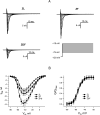Distinct effects of obesity and diabetes on the action potential waveform and inward currents in rat ventricular myocytes
- PMID: 39693640
- PMCID: PMC12203996
- DOI: 10.1042/CS20242144
Distinct effects of obesity and diabetes on the action potential waveform and inward currents in rat ventricular myocytes
Abstract
Obesity is a significant global health challenge, increasing the risk of developing type 2 diabetes mellitus (T2DM) and cardiovascular disease. Research indicates that obese individuals, regardless of their diabetic status, have an increased risk of cardiovascular complications. Studies suggest that these patients experience impaired electrical conduction in the heart, although the underlying cause-whether due to obesity-induced fat toxicity or diabetes-related factors-remains uncertain. This study investigated ventricular action potential parameters, as well as sodium (INa) and calcium (ICa, L) currents, in Zucker fatty (ZF) rats and Zucker diabetic fatty (ZDF) rats, which serve as models for obesity and T2DM, respectively. Ventricular myocytes were isolated from 25- to 30-week-old Zucker rats. Resting and action potentials were recorded using a β-escin perforated patch clamp, while INa and ICa,L were assessed with whole-cell patch clamp methods. ZF rats exhibited higher excitability and faster upstroke velocity with greater INa density, whereas ZDF rats showed decreased INa and slower action potential upstroke. No differences in ICa,L density or voltage sensitivity were found among the groups. In summary, obesity, with or without accompanying T2DM, distinctly impacts the action potential waveform, INa density, and excitability of ventricular myocytes in this rat model of T2DM.
Keywords: Zucker rat; action potential; type 2 diabetes; voltage-gated Ca2+current; voltage-gated Na+current.
© 2025 The Author(s); published by Portland Press Limited on behalf of the Biochemical Society.
Conflict of interest statement
The authors declare that there are no competing interests associated with the manuscrip
Figures




Similar articles
-
A Better Understanding of Atrial-like and Ventricular-like Action Potentials in Stem Cell-Derived Cardiomyocytes: The Underestimated Role of the L-Type Ca2+ Current.Cells. 2025 Aug 8;14(16):1226. doi: 10.3390/cells14161226. Cells. 2025. PMID: 40862705 Free PMC article.
-
The metamorphosis of amphibian myocardium: moving to the heart of the matter.J Exp Biol. 2024 Oct 15;227(20):jeb247712. doi: 10.1242/jeb.247712. Epub 2024 Jun 25. J Exp Biol. 2024. PMID: 38916053
-
Inhibition of tenascin C rescues abnormally reduced Na currents in dystrophin-deficient ventricular cardiomyocytes.Am J Physiol Heart Circ Physiol. 2025 Sep 1;329(3):H648-H660. doi: 10.1152/ajpheart.00307.2025. Epub 2025 Aug 11. Am J Physiol Heart Circ Physiol. 2025. PMID: 40789177
-
Dipeptidyl-peptidase (DPP)-4 inhibitors and glucagon-like peptide (GLP)-1 analogues for prevention or delay of type 2 diabetes mellitus and its associated complications in people at increased risk for the development of type 2 diabetes mellitus.Cochrane Database Syst Rev. 2017 May 10;5(5):CD012204. doi: 10.1002/14651858.CD012204.pub2. Cochrane Database Syst Rev. 2017. PMID: 28489279 Free PMC article.
-
Diet, physical activity or both for prevention or delay of type 2 diabetes mellitus and its associated complications in people at increased risk of developing type 2 diabetes mellitus.Cochrane Database Syst Rev. 2017 Dec 4;12(12):CD003054. doi: 10.1002/14651858.CD003054.pub4. Cochrane Database Syst Rev. 2017. PMID: 29205264 Free PMC article.
References
MeSH terms
LinkOut - more resources
Full Text Sources
Medical
Miscellaneous

